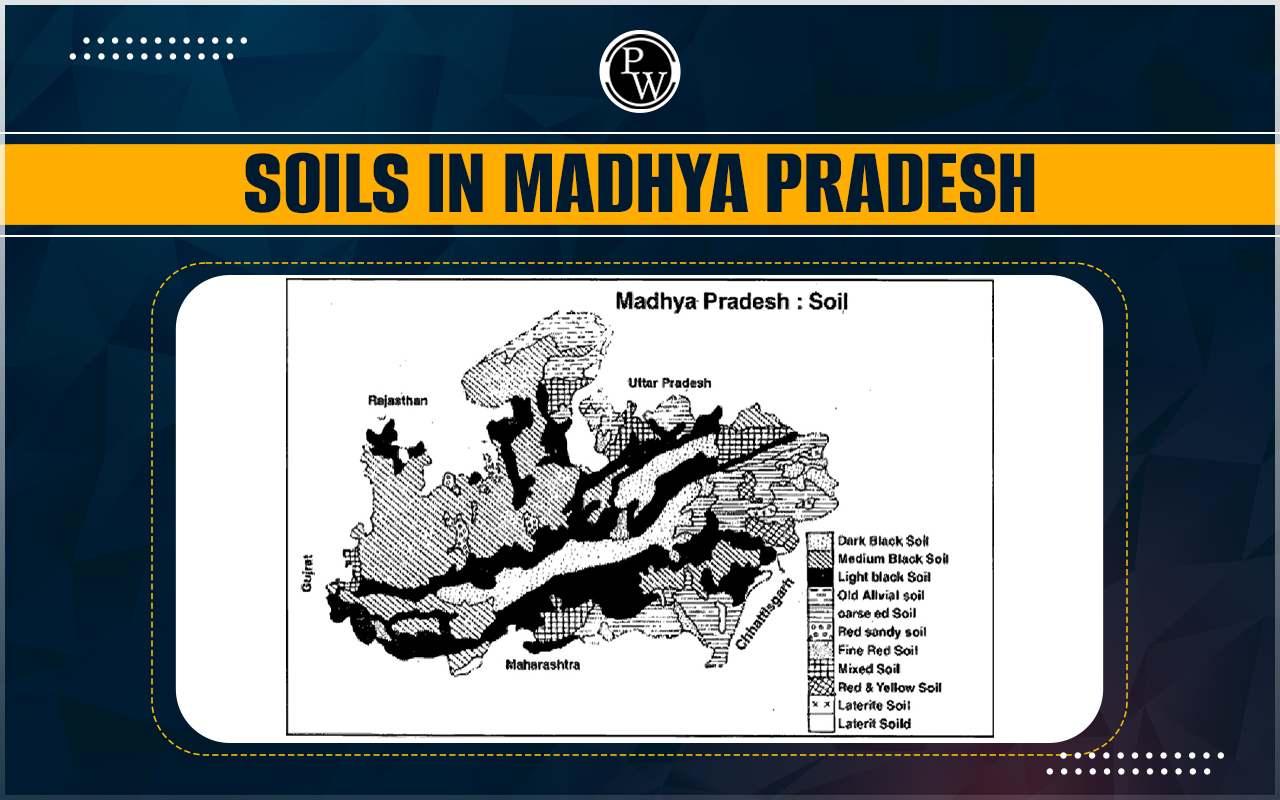
Soils in Madhya Pradesh: Madhya Pradesh, often referred to as the heart of India, is blessed with a diverse range of soils that play a crucial role in shaping its agricultural landscape. From the fertile plains nourished by alluvial deposits to the unique black cotton soils that support extensive cotton farming, the soils in Madhya Pradesh are as varied as its topography.
This blog delves into the different types of soils found in the state, their distribution, characteristics, and the crops they support. Furthermore, it addresses the pressing issue of soil erosion, exploring its causes, types, and effective preventive measures to ensure sustainable land use and agricultural productivity.
Soils in Madhya Pradesh
Madhya Pradesh, located in the heart of India, is known for its rich and diverse natural resources, including a variety of soil types that support its agricultural economy. The state's soils are integral to its agriculture, influencing crop choices, farming practices, and overall productivity. This blog provides an in-depth look at the soils of Madhya Pradesh, including their types, distribution, characteristics, the issue of soil erosion, its causes, types, and preventive measures.
Soils in Madhya Pradesh Overview
Madhya Pradesh, with its vast expanse and varied topography, boasts a diverse soil profile. The state's soils are primarily derived from the weathering of ancient rocks and are influenced by climatic conditions, vegetation, and human activities. The fertility and characteristics of these soils play a crucial role in the state's agricultural productivity.
| Soils in Madhya Pradesh Overview | |||
| Soil Type | Distribution | Characteristics | Chief Crops |
| Black Cotton Soil (Regur Soil) | Malwa Plateau, Narmada Valley |
|
Cotton, soybean, wheat, sorghum |
| Red and Yellow Soil | Eastern and Southeastern regions |
|
Millet, groundnut, pulses |
| Alluvial Soil | Northern regions, river valleys |
|
Wheat, rice, sugarcane |
| Laterite Soil | Southern parts |
|
Tea, coffee, cashew nuts |
| Mixed Red and Black Soil | Central parts |
|
Cereals, pulses, oilseeds |
Importance of Soils in Madhya Pradesh for Agriculture and Economy
Soils in Madhya Pradesh are a foundational element for its predominantly agrarian economy. They determine the types of crops that can be cultivated, affecting food security and income for millions of farmers. The state produces a wide range of crops, including wheat, rice, soybeans, and pulses, relying heavily on its soil resources.
Types of Soils in Madhya Pradesh
Madhya Pradesh features several soil types, each with distinct characteristics and suitability for different crops. Below, we delve into the types, distribution, characteristics, and chief crops associated with each soil type.
Black Cotton Soil (Regur Soil)
Types
Black Cotton Soil, also known as Regur soil, is one of the most prominent soil in Madhya Pradesh. Black Cotton Soil is rich in clay and has excellent moisture-retaining capacity. It is ideal for cotton cultivation, hence the name. This soil is also suitable for crops like soybean, wheat, and sorghum.
Distribution
This soil is predominantly found in the Malwa Plateau and Narmada Valley regions.
Characteristics
- Texture : Clayey
- Color : Deep black due to the presence of iron and aluminum oxides.
- Moisture Retention : Excellent, which makes it ideal for rainfed agriculture.
- Nutrient Content : Rich in lime, iron, magnesia, and alumina but poor in phosphorus and organic matter.
Chief Crop
Cotton is the chief crop grown in Black Cotton Soil. Other significant crops include soybeans, wheat, and sorghum.
Red and Yellow Soil
Types
Red and Yellow soils are less fertile but widespread in the state. Found predominantly in the eastern and southeastern regions, Red and Yellow soils are less fertile compared to black soils but support crops like millet, groundnut, and pulses. These soils are derived from granite and gneiss rocks and are known for their poor organic matter content.
Distribution
These soils are primarily found in the eastern and southeastern parts of Madhya Pradesh.
Characteristics
- Texture : Sandy to loamy
- Color : Red due to the presence of iron oxide, turning yellow when hydrated.
- Moisture Retention : Moderate, with lower fertility compared to black soils.
- Nutrient Content : Poor in nitrogen, phosphorus, and humus.
Chief Crop
Millet, groundnut, and pulses are commonly grown in these soils.
Alluvial Soil
Types
Alluvial soil is highly fertile and supports a variety of crops. Alluvial soils are prevalent in the northern parts of Madhya Pradesh, particularly along the river valleys. These soils are highly fertile, supporting a variety of crops, including wheat, rice, and sugarcane. They are formed from the sediments deposited by rivers.
Distribution
Found predominantly in the northern regions, especially along the river valleys like the Chambal and Betwa.
Characteristics
- Texture : Sandy to clayey
- Color : Light brown to gray.
- Moisture Retention : High, due to fine particles.
- Nutrient Content : Rich in potash, phosphoric acid, and lime but occasionally deficient in nitrogen and organic matter.
Chief Crop
Wheat, rice, and sugarcane are the primary crops grown in alluvial soil.
Laterite Soil
Types
Laterite soils are rich in iron and aluminum but have lower fertility. Laterite soils are found in the southern parts of Madhya Pradesh. These soils are rich in iron and aluminum but poor in nitrogen and phosphorus. They are suitable for crops like tea, coffee, and cashew nuts.
Distribution
These soils are found in the southern parts of Madhya Pradesh.
Characteristics
- Texture : Loamy to clayey
- Color : Reddish-brown due to iron content.
- Moisture Retention : Moderate.
- Nutrient Content : High in iron and aluminum but poor in nitrogen, potassium, and organic matter.
Chief Crop
Tea, coffee, and cashew nuts thrive in laterite soils.
Mixed Red and Black Soil
Types
Mixed Red and Black soils combine the features of both soil types. This type is a combination of red and black soils, found in parts of central Madhya Pradesh. They have intermediate characteristics and support diverse crops, including cereals, pulses, and oilseeds.
Distribution
These soils are found in parts of central Madhya Pradesh.
Characteristics
- Texture : Varies from sandy to clayey.
- Color : Reddish-black.
- Moisture Retention : Intermediate between red and black soils.
- Nutrient Content : Balanced nutrients from both red and black soils.
Chief Crop
A variety of crops, including cereals, pulses, and oilseeds, are grown in these soils.
Erosion of Soil in Madhya Pradesh
Soil erosion is a significant environmental issue in Madhya Pradesh, impacting soil fertility and agricultural productivity. The state's diverse topography and climatic conditions contribute to varying degrees of soil erosion across different regions.
Reasons for Soil Erosion in Madhya Pradesh
Several factors contribute to soil erosion in Madhya Pradesh, including natural processes and human activities.
Natural Factors
- Rainfall Intensity and Pattern : Heavy monsoon rains can lead to significant soil erosion, especially on slopes and unprotected lands.
- Topography : Hilly and undulating terrains are more prone to erosion due to gravity and water runoff.
Human Activities
- Deforestation : Clearing of forests for agriculture and urbanization reduces vegetation cover, leading to increased erosion.
- Overgrazing : Excessive grazing by livestock depletes grass cover, leaving soil exposed to erosion.
- Unsustainable Agricultural Practices : Practices like monocropping, excessive tillage, and lack of crop rotation degrade soil structure and increase erosion risk.
Erosion Types for Soils in Madhya Pradesh
Soil erosion in Madhya Pradesh manifests in several forms, each with distinct characteristics and impacts.
Water Erosion
Water erosion is the most common type, caused by rainfall and surface runoff. It includes:
- Sheet Erosion : Uniform removal of soil layers by raindrop impact and surface flow.
- Rill Erosion : Formation of small channels by concentrated runoff.
- Gully Erosion : Larger channels or gullies formed by intense water flow, leading to significant soil loss.
Wind Erosion
Wind erosion is prevalent in arid and semi-arid regions. It involves the removal of topsoil by strong winds, especially during dry seasons when the soil is loose and bare.
Preventive Methods for Erosion of Soils in Madhya Pradesh
Addressing soil erosion requires a combination of traditional knowledge and modern techniques to ensure sustainable land management.
Afforestation and Reforestation
Planting trees and restoring forests help stabilize the soil, reduce runoff, and improve water infiltration.
Contour Plowing and Terracing
Plowing along the contours and creating terraces on slopes help reduce water runoff and soil erosion.
Cover Crops and Crop Rotation
Growing cover crops and practicing crop rotation enhance soil structure, reduce erosion, and improve soil fertility.
Conservation Tillage
Minimizing tillage helps maintain soil structure and organic matter, reducing erosion risk.
Check Dams and Water Harvesting Structures
Constructing check dams and other water harvesting structures reduce runoff velocity, promote groundwater recharge, and minimize soil erosion.
Education and Awareness
Educating farmers and local communities about sustainable agricultural practices and soil conservation techniques is crucial for long-term soil health.
Soils in Madhya Pradesh <span style=
Q.1 Which type of soil is found in Madhya Pradesh?
Q.2 Which soil is most fertile in MP?
Q.3 What type of soil is in Indore?
Q.4 Which black soil is not found in MP?











